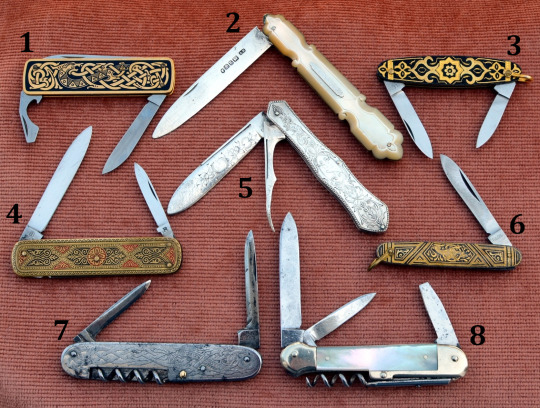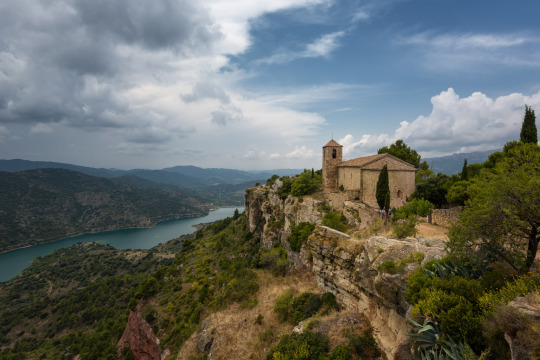#20th c. spain
Text

Flamenco dancer by James Durden (Manchester 1878 - 1964)
60 notes
·
View notes
Text

8 Fancy Pocket Knives
Etched pocket knife from Eskilstuna, Sweden
Silver / mother of pearl Victorian fruit knife, England
Damascene Toledo knife, Spain
Inlaid Toledo knife, Germany
Silver-plated fruit knife, USA
Damascene Toledo knife, Spain
Etched pocket knife from Eskilstuna, Sweden
Mother of pearl pocket knife from Eskilstuna, Sweden
@victoriansword [details after the cut]
1) Swedish pocket knife by EKA (Eskilstuna Kniffabriks AB), c. 1980-2000. Model 6 GS (1967-2010), with main blade, bottle opener/screwdriver, pen blade, and nail file. Tang stamp "EKA / SWEDEN" (from 1967), etched handle, 7 cm closed.
These were very popular in the 2nd half of the 20th century as gift knives or advertising knives. They were manufactured by many cutlers in Eskilstuna, and widely exported. The decorative pattern appears, with variations, on Swedish knives from at least the 19th century, and is inspired by Norse / Viking art, which often features twisted serpents/dragons. The interlacing perhaps also borrows from Celtic knots.
2) English fruit knife by Martin Bros & Co, 1848. Silver blade with 4 hallmarks (for Queen Victoria, the year, sterling silver, and Sheffield) and maker's mark, mother of pearl scales, 9.5 cm closed.
This is the posh version of what used to be an incredibly useful tool, a knife (and sometimes a multi-tool knife and fork) for eating on the road. The fancier ones were also status symbols, and very popular gifts – millions of silver fruit knives were manufactured in Britain from the 18th to the 20th century, mostly in Sheffield, Birmingham, and Edinburgh.
3) Spanish Toledo knife, as it's sometimes called, a damascened penknife of recent manufacture. Two pen blades, tang stamp "TOLEDO", 6.7 cm closed.
Not to be confused with Damascus blades! The handle is damascened – decorated with gold inlaid into oxidized steel (see here for details). Reminder that gold is a highly ductile metal (you can stretch it real thin before it breaks), so that impressive aesthetic result comes from a tiny amount of gold. It's a cheap knife, is what I'm saying, for tourists basically.
4) German pocket knife, confusingly also called Toledo, by Hartkopf. With main blade, pen blade and nail file. Brass handle inlaid with oxidised steel. Tang stamp "Hartkopf&Co / Solingen", 8cm closed.
It's "damascened" in the broad sense of inlaying, hence the name "Toledo": it supposedly emulates the Spanish style, and perhaps pretends to be Spanish, but both the metals and the geometric patterns are different. Knives of this type were popular in Germany all through the 20th century as gifts and advertising knives.
5) American fruit knife by William Rogers Mfg, made in Hartford, Connecticut c.1865-1898. Main blade, seedpick [also called nut-pick or nut-picker *snickers*], silver-plated nickel silver, decorated with flowers and apples. Tang stamp: an anchor logo and "Wm ROGERS & SON AA", 8.2 cm closed.
Sometimes fruit knives like this were bought by fruit shops/groceries (relatively fancy ones, presumably) in bulk, and sold or given to customers as gifts.
6) Spanish Toledo penknife (another one). With pen blade and damascened handle, different pattern, probably a bit older. Tang stamp again "TOLEDO", 6.8 cm closed.
7) Swedish pocket knife by Emil Olsson, c. 1920-1950. Blade, pen blade and corkscrew. Tang stamp "EMIL OLSSON / [star logo] / ESKILSTUNA", 9.2 cm closed.
Another etched serpent pattern on the handle, though by now you have to squint to see it. This knife has seen some shit. Until ~1940, pocket knives were widely sold and used in Sweden because they came with corkscrews, and all the bottles had corks, and everyone needed to open bottles. After the war, bottle caps replaced corks for everything except wine, and the pocket knife's utility plummeted, and cutleries started closing. There used to be hundreds, and by now only EKA's left. So statistically, if it's from before ~1950 it saw a lot of use, and if it's after ~1950 it did not, it was a gift or something.
8) Swedish pocket knife by EKA, c.1935-1965. Model 38 PB, with blade, pen blade, flat screwdriver, and corkscrew. Handle with mother of pearl scales and nickel silver bolsters, tang stamp "E.K.A. / ESKILSTUNA / SWEDEN", 8.3 cm closed.
The corkscrew is a quirky one, known as Gottlieb Hammesfahr patent: it pivots on the pin and opens perpendicular to the handle, not pulled downwards as in most pocket knives.
#tools of the trade#folding knife#sweden#sheffield#spain#germany#toledo#eskilstuna#solingen#usa#trs#trp#trc#how to stab#<- the knife nerd tag
23 notes
·
View notes
Text

Proclamation to the People of New Orleans
Record Group 233: Records of the U.S. House of RepresentativesSeries: Presidential MessagesFile Unit: President's Messages from the 8th Congress
PROCLAMATION. By his Excellency William C.C. Claiborne, Governor of the Missisippi Territory, exercising the powers of Governor General and Intendant of the Province of Louisiana. WHEREAS, by stipulations between the governments of France and Spain, the latter ceded to the former the Colony and Province of Louisiana, With the same extent which it had the date of the above mentioned treaty in the hands of Spain, and that it had when France possessed it, and such as it ought to be after the treaties subsequently entered into between spain and other states; and whereas the government of France has ceded the same to the United states by a treaty duly ratified, and bearing date the 30 of April in the present year, and the possession of said Colony and Province is now in the United States according to the tenor of the last mentioned treaty; and whereas the Congress of the United States, on the 31st day of Oct. in the present year, did enact that until the expiration of the session of Congress then sitting, (unless provisions for the temporary government of the said territories be sooner made by Congress,) all the military, civil and judicial powers exercised by the then existing government of the same, shall be vested in such person or persons, and shall be exercised in such manner as the President of the United states shall direct, for the maintaining and protecting the inhabitants of Louisiana, in the free enjoyment of their liberty, property and religion; and the President of the United states, has by his commission, bearing date the same 31st day of October, invested me with all the powers, and charged me with the several duties heretofore held and exercised by the Governor General and Intendant of the Province: I HAVE therefore thought fit to issue this my PROCLAMATION making known the premises, and to declare that the government heretofore exercised over the said Province of Louisiana, as well under the authority of Spain as of the French republic, has ceased, and that of the United states of America is established over the same; that the inhabitants thereof will be incorporated in the union of the United states, and admitted as soon as possible, according to the principles of the Federal Constitution, to the enjoyment of all the rights, advantages and immunities of citizens of the United states; that in the mean time they shall be maintained and protected in the free enjoyment of their liberty, property, and the religion which they profess; that all laws and municipal regulations which Were in existence at the cessation of the late government, remain in full force, and all civil officers charged with their execution, except those whose powers have been specially vested in me, and except also such officers as have been entrusted with the collection of the revenue are continued in their functions during the pleasure of the governor for the time be ing, or until provision shall otherwise be made. And I do hereby exhort and enjoin all the inhabitants and other persons within the said Province, to be faithful and true in their allegiance to the United states, and obedient to the laws and authorities of the same, under full assurance that their just rights will be under the guardianship of the United states, and will be maintained from all force or violence from without or within. In testimony whereof I have hereunto set my hand. [Indented more toward the right than previous sections] Given at the City of New-Orleans the 20th day of December 1803, and of the Independence of the United states of America the 28th. William C. C. Claiborne. [full transcription at link]
27 notes
·
View notes
Text
Chapter 204 Trivia
What we thought may be a politics arc may in fact become a brotherly feud…

Galileo's quote is taken from his book "The Assayer", considered to be one of the pioneering works of the scientific method. At the time, most science was done by philosophical arguments rather than observation and trying to understand the mathematics behind them.


Math is the universal language because the symbols may change, but the meanings/axioms cannot. Because of this, the cover of the Golden Record placed on Voyager 1 (the probe leaving our solar system) has instructions written in math in the hopes some future beings can understand.



Ryusui wasn't wearing two swords last chapter, I wonder where they came from and why he's wearing them now…
(Maybe this is why Sai was running from him haha!)

Mathematical errors have ruined a lot of space missions: the Mariner 1 was destroyed because of a missing hyphen, and the Mars Climate Orbiter was destroyed on landing because of a failure to convert units.
Avoiding these errors was very difficult when it was all done by hand.


This seems to be at least partially true, however the practice has lessened over the decades. Indian-educated parents and grandparents may remember, but students these days probably only need to learn up to 19x19!


The HR industry in India is incredibly large, and are a very useful resource to have for any business looking to scale up. It's not surprising that the Nanami Corporation set up a university there!

Sai appears to be the 554th most popular name in India and can be used for both genders, but it's generally a male name.

The equations in the background here I haven't identified yet, but the gamma (γ) thrust here may be alluding to the thrust equation used with rocket engines in space. The gamma is the specific heat ratio of the gas.


The day is October 1st, so the team likely left Spain sometime between September 15th-20th if it did in fact take them 10 days to travel the distance (with some delays because of the Suez situation).

The food here may be a somewhat generic curry as the sound effect seems to indicate, or it could also be lamb gosht based on the color, region, and spices used.

Technically we don't know that Ruri specifically called for the defensive positions, but we do know everyone in Japan is probably in them.


I think this is the same sky image as the one Tsukasa saw in chapter 188, but with a different star pattern.


The Fellenius method and what Senku is actually doing here is dividing the slopes into segments and calculating how stable each one is using the properties of the dirt and rock. Putting the segments together should give you how likely a rock slide is. Strata are layers of rock.


The many-armed pose Sai is found in is a reference to Durga, a major Hindu deity. She is associated with protection, strength, motherhood, destruction and wars.


This comment I believe is Chelsea's from the "I'm not a fan" part, with the "baaad" learnt from Chrome's habit.
The meaning of her comment is confusing, but it might be because the last pretty-boy character introduced was a villain (Stanley), however shes also a fan of Hyoga…?


Sai's outfit is very simple and rather lacking compared to Ryusui's, however they share elements such as the collar type and addition of a belt.

The belt buckle is very interesting, it doesn't follow Ryusui's nor Nanami Corp.'s branding and looks like a C+.
My guesses for the meaning:
-C+, the programming language, based off the fact he was petrified on his laptop presumably.
-C, the Roman numeral, indicating 100+ because of the million-times brainpower comment (million in Japanese is 百万, 百=100).
-C, from E=mc^2, for light speed.
Sai's odd yell ("peegyaaaah!") may be a computer joke, as the sound effect "ピ" (pi) tends to be used for computer beeps, like pressing a button.
A similar sound has been used in the past for Xeno's encryption device.


Sai's character could go a lot of directions since he's unlikely to be one of the traditional nerds they described, nor one like Joel since Joel exists. What Ryusui did to scare off his older brother though, I'm very curious about…
#trivia#dr stone#chapters#sai nanami#204#bit of me-trivia here: i got spoiled from the leaks from someone updating ryusui's wiki page to include sai and i assumed it was a joke#until i read the chapter and was like “ah.”#i still wish there were more hints to sai's existence before he suddenly appeared out of nowhere
24 notes
·
View notes
Note
Spoken natively by half a billion people across twenty-some countries, Spanish will hit you with some rich linguistic differences.
For starters, soft C (ce and ci) and Z in most of Spain including Madrid and therefore the standard in the country; gets pronounced as /θ/, same sound as the TH in English found in words like thinking.
However, on the Canary Islands and in the Americas, soft C and Z get pronounced just like /s/, this phenomena gets called "seseo." This is why everyone you know in real life pronounces it like that. This is the way I speak it and most Spanish speakers do.
Countries have lots of different ways to refer to things. In Spanish class we even had parts of the course dedicated to explore the dialect differences of other nations for enrichment I guess.
You are not bad at Spanish here, it's just that sometimes the different peoples will have a whole different word for the same thing.
Let's look at the three words you mentioned.
BEAN 🫘
I call it "frijol" but other derivate words people use to refer to such legume are frejol, fréjol, fríjol, frijón, frisol, frísol and frisuelo.
Argentina, Uruguay, Bolivia, Paraguay and Chile call it "poroto"; depending on where you are on Spain, it will be "judía", "alubia", "faba" or "habichuela"; and in Venezuela it's "caraota".
SANDWICH 🥪
From the English word, some people will call it "sándwich"; or more closely appealing to Spanish's phonotactics: "sánguche". Some people will pronounce it as if the word was "changüich".
The word "emparedado" also exists. Spain calls it "bocadillo" but that same word in other countries can refer to a snack or a packed lunch. In some other countries, if it's for example a ham sandwich they will call it "pan con jamón". Some people that clearly don't understand Mexican gastronomy will tell you in Mexico they call sandwiches "tortas" but that's only true if the bread is one of these:

Also "torta" means cake in other countries; I call cake "pastel", others will use "tarta".
COMPUTER 💻
The English word describes the machine was one that computes, a.k.a calculates. I call it "computadora" but on Chile and Colombia it is "computador."
However, in the 50's a French philospher thought such word was quite restrictive of what a computer can do, just not do math; a computer can organize and bring order. So the French created the word "ordinateur" and in Spain it's "ordenador."
Interesting how this is a 20th century technology word and we see a divide between Europe and the Americas. It reminds me of 📱🤳, in the U.K. and Spain it is "mobile" and "móvil"; and in the U.S. and Latin America it is "cellphone" and "celular."
Of course, teaching courses, media, dubbing, networks and international broadcasting will have to make a choice on what words to use. I have seen many memes of little kids using the words they see in dubbed cartoons that try to appeal to a neutral Spanish that is quite different from the vocabulary used in their environment. When Minecraft YouTubers from Spain became popular in the early to mid 2010's; the Latin American kids started to copy their vocabulary and swearing. There are dubbings that make little changes to create different versions for different countries, and there are others that heavily marinate the dialogues into a dialect and throw in references to appeal more to the audience [Like Shrek and Mexican Spanish]. The different dialects of Spanish bring curiosity and adoption of words, but also disharmony and judgement in the Spanish-speaking internet; it can be like war out there, also this is based on the rivalries you can sometimes see between the internet users of different countries (Argentina and Mexico is a heavy one).
Anyways back to Duolingo, when I used it for French I was mad the app marked wrong my answer because I said "frijoles" and not "porotos."
That's a lot of very good information! This is part of the reason it's so difficult to learn a language through an app. You miss out on the "why" of things 100% of the time but also most of the time you lose out on the option to ask questions. In Spanish class u can just raise ur hand and say I don't get it! What does this mean? But with an app u just gotta.. trust whatever the first 3 people that u can find in a google search. I'm mad duolingo decided to... do all that. Not because it was the best way to learn a language, but because it was very accessible as a free option and I was familiar with it. If I didn't work full time + could afford it I'd be taking actual lessons. But it seems I'm doomed to flail my way into learning with the options available to me asdfkskkcks thanks for all the info rye
5 notes
·
View notes
Photo

“On this day in 1976, the David Bowie LP “The Rise and Fall of Ziggy Stardust and the Spiders from Mars” re-entered the US Billboard 200 Album Chart at #160 (March 6).
Originally released in 1972, this is widely considered to be Bowie's breakthrough album. The record is a loose concept album based around the character Ziggy Stardust, a fictional androgynous rock star who is sent to Earth as a saviour before an impending apocalyptic disaster. The title track is about Stardust growing too conceited: "Making love with his ego, Ziggy sucked up into his mind." Stardust's band, The Spiders From Mars, consequently plan to get revenge on the egotistical front man: "So we bitched about his fans, and should we crush his sweet hands?" Bowie said that the song is "about the ultimate rock superstar destroyed by the fanaticism he creates. "In 1993, Bowie discussed the “look” he was going for: “The idea was to hit a look somewhere between the Malcolm McDowell thing with the one mascaraed eyelash and insects. It was the era of Wild Boys, by William S. Burroughs ... [It] was a cross between that and Clockwork Orange that really started to put together the shape and the look of what Ziggy and the Spiders were going to become ... Everything had to be infinitely symbolic.”In 1987, as part of their 20th anniversary, Rolling Stone ranked it #6 on "The 100 Best Albums of the Last Twenty Years". In 2020, Rolling Stone ranked it #40 on their list of the 500 Greatest Albums of All Time.In March 2017, the album was selected for preservation in the National Recording Registry by the United States National Recording Preservation Board, which designates it as a sound recording that has had significant cultural, historical, or aesthetic impact in American life. The album peaked at #2 in Spain, #5 in the UK, #11 in Australia, #59 in Canada, and #75 in the US. A re-release after Bowie’s death in 2016 saw the album back in the charts, this time peaking at #21 in the US.”
Click on the link below to watch a brilliant live performance from 50 years ago:https://youtu.be/3qrOvBuWJ-c
Daily Rock History
17 notes
·
View notes
Text
Last week, while in Spain, I found out about the existence of fan shops.
No, not the kind where supporters of Real or Barça can buy jerseys and branded cereal bowls; I'm talking about a shop selling hand-held fans. We're not talking about those cheap, badly-painted ones sold for a few Euros to tourists; some of the fans securely protected behind glass with prices well north of 100 Euros, clearly meant to be either displayed or worn with local traditional clothing.
I ended up going in and buying one the shape and colour of which I liked and that I think it will look well with my c. 1798-1805 outfit and possibly with my own traditional garb of a wholly different place (though I think the make is more of a late 19th/early 20th century design), boxed and wrapped in dark-green paper.
Looking back on it, I probably will never get as close to an accidental time travel again as this sales conversation over which model, size and colour of fan to get.
#r rambles#r travels#spain#i might come back someday and then i'll buy another fan because you can never have enough of those right
12 notes
·
View notes
Note
didn’t know about spain and morocco’s history before the wc. Now i’m even more glad they won
I’m confused as to where this is coming from, a post or just a random thought…But, yes, Spain has had and still has a violent history even if their current government proclaims itself as left-leaning. Not only towards other countries/cultures but to it’s own people (Civil War and dictatorship mid to end of 20th century was awful). Same with most European countries. Funny thing is that a couple of the Moroccan players in the NT were born and raised in Spain of Moroccan parents but in Spain you are not born a citizen (although you can live there) c only if one of your parents is a Spanish citizen, then you can be citizen too. Even if born there, you take your parents citizenship that’s why most of them can easily play for Morocco instead of the place where they lived; Spain, they decided to play for their culture. For example: Hakimi was born and raised in Madrid.
I didn’t like the defensive style Morocco played that specific game against Spain but the Moroccan team was espectacular during the WC and totally deserved to be in the Semi finals

This was a mural in Barcelona praising immigrant moms after the world cup. There is a large Moroccan community in Barcelona.
15 notes
·
View notes
Text


OTD in Music History: Important 20th Century Spanish composer and conductor Manuel de Falla (1876 - 1946) is born in Cadiz.
Widely hailed as one of the greatest Spanish composers in history, de Falla actually lived and studied in France for many years during his youth. Following the tremendous international success of his ballet "El sombrero de tres picos" ("The Three-Cornered Hat," 1917), however, he relocated to Granada, Spain -- where, in 1922, he organized an Andalusian folk music festival and composed a puppet opera entitled "El retablo de Maese Pedro" ("Master Peter's Puppet Show," 1923). Like his subsequent Harpsichord Concerto (1926), which also contains prominent echoes of Domenico Scarlatti (1685 - 1757), "El Retablo" is a neoclassical work which shows Falla much influenced by Igor Stravinsky (1882 - 1971). After 1926, however, he wrote very little, instead enjoying a quiet retirement in Spain before moving to Argentina in the wake of the Spanish Civil War.
de Falla's other important works include his ballet "El amor brujo" ("Love, the Magician") (1915), which contains the well-known "Ritual Fire Dance," and his tone poem "Noches en los jardines de España" ("Nights in the Gardens of Spain") (1916).
PICTURED: A c. 1930s real photo postcard, showing the elderly de Falla.
#classical music#composer#symphony#orchestra#music history#conductor#Manuel De Falla#De Falla#pianist#Piano#Nocturne#classical#classical composers#classical singer#classical composer
13 notes
·
View notes
Text
Matriarchy, Feminism and 8th of March

First of all I might say that everything I am doing is inspired by women and for women.
And of course this day is not about showing the love , because love is an action ( according to E.Fromm) , which should be done /manifested every day.
This day is actually about the woman rights and power , and about remembering of those who was fighting for this rights.
Women received the right to vote during the 20th century:
Earliest 1910s - US
And one of the latest in Europe is Spain - 1970s
One of latest countries where women received the right to vote is Saudi Arabia in 2015.
In 2023 Vatican still not says if women could vote.
2020
The UN theme for International Women's Day was: 'I am Generation Equality': Realizing Women's Rights'.
March in Pakistani called «Aurat March» was marred by attacks from stone throwers, after a failed attempt to have it banned as un-Islamic.
And this is happening in 2020 !!!
In April 2019, cleric Jawad Naqvi had called march organizers "the most evil of all women".
In Bishkek, the capital of Kyrgyzstan, police detained dozens of marchers shortly after masked men reportedly attacked the march.
And the most terrible things are happening now in Iran , where people are shooted from machine-guns for support of women rights
Not-surprising that russia and Iran are united, because they are the same kind of evil and yearn for each other.
But it wasn’t always like this.

The thing is that living in some period of time we accept some things (social constructs for example) for given. We refer for some concepts as static , however history shows us that they are not.

If we refer to the most ancient myths , we can discover that the primordial and supreme Deity was Goddess , thus Woman
In Greek Mythology - Gaia - is Mother Earth, her husband is Uranus. Her first sun - Kronos , and after son of Kronos - Zeus seized power in Olympus.
In Shumer Mythology this is Istar.
«The idea of primal female deity , first adored , then brutally side-lined by a male deity is a consistent theme in mythologies around the world.
The Tantrik tradition of India speaks of the primal one, Adya, who took the form of a bird and laid three unfertilised eggs from which were born Brahma, Vishnu and Shiva.
Egyptian mythology acknowledges a time before gender. Then there was Atum, ‘the Great He-She’, who brought forth the god of air Shu and the goddess of dew Tefnut who separated Geb, the earth-god, from Nut, the sky-goddess, who gave birth to Isis and Osiris, the first queen and king of human civilisation. Then Seth killed Osiris and declared himself king, until Isis gave birth to Horus and contested his claim.
In these stories from around the world, the male deities compete for the female prize. This can be traced to nature, where all wombs are precious but not all sperms. So the males have to compete for the female. In many bird species, the female chooses the male with the most colourful feathers, the best voice or the best song, or with the capability of building the best nest. In many animal species, such as the walrus and the lion, the alpha male keeps all the females for himself; thus there are always ‘remainder’ males who do not get the female. This selection of only the best males creates anxiety amongst the not-so-good males and translates into the fear of invalidation in the human species. To cope with this fear of invalidation, social structures such as marriage laws and inheritance rights come into being, often at the cost of the female.
As human society learnt to domesticate animals and plants, trade and build cities, we see a gradual shift in social laws, deterioration in the status of women, and rejection of Goddess-worship in favour of God-worship.»
(C) Devdutt Pattanaik - 7 Secrets of Goddess

A few anthropologists even argue that Krishna’s dance Raasa-Leela may have its roots in old matriarchal tribes where the women valued only one male of the village.
In such female-dominated cultures, the male could not refuse the woman: in the Mahabharata, when Arjuna refuses her advances, Urvashi curses him to turn into a eunuch. Any man who forced himself upon a woman was killed.
To ensure that the dominant males did not have exclusive and eternal rights to women, the ritual of killing the chosen males at regular intervals emerged.
The only way to survive being killed at the end of the term as king and consort of the Goddess was by castrating oneself. And so in the Near East, the priests of Cybele, called the Galli, ritually castrated themselves emulating Attis, the castrated son/lover of the goddess.
Of course that are rather bloody practices , but now the pendulum has swung in another direction.

In Astrology the 8th House represents all the Unknown , Mystic , Sex and Death.
The connection of Sex and Death we can trace in myths across the Globe as well.
The close connection of sex and death, sex and pleasure, and pleasure with women led to that men began to associate women with amorality , suffering and vulnerability.
Renunciation of women guaranteed freedom from suffering.
This we can trace in Biblical mythology: Samson succumbed to passion for the insidious Philistines Delilah and losses his power.
In Buddhism the daughters of Mara ( the greatest Demon) are associated with decay sickness and death. Rejecting them Gautamma Siddhartha gained freedom from suffering.
In Tantra and Yogic tradition we have practice called - Brahmacaṛya ( celibacy ) which is supposed to give a mystical powers called «Siddhi»
We can see how along the course of history men tried to cheat biology.
Also in Hindu there is a tradition called «Sati» ( in name of wife of Shiva who stepped into the fire ,when her husband was offended)
It is supposed that the fidelity of a woman gave her magical powers. This believe in «sati» has led to concept - if man died for whatever reason , it was the cheating wife who couldn’t prevent it. She was encouraged to burn herself on a funeral pyre to prove her purity.
The time goes on and there is a power struggle in the cities - and women becomes a trophy in this game - «Helene of Troy»
All this leads to the isolation of women for their «own safety»
Woman become a commodity , she loses the ability to control her life and her body.
At some time the men took over all economic activity , and the only activity available for women was a temple prostitution.
The body of woman, so as the land was owned by a father, brother, husband and even son.
The main reason of invention of the proprietary rights - is the fear and insecurity of men.
Gradually, the gaze turned upwards towards the sky. Gravity became a fetter, the earth a trap, and women bondage. Escape was sought. The serpent, messenger of the goddess, was rejected in favour of winged beings or angels who take humanity to ‘higher’ realms, above the earth.
In biblical mythology, the serpent becomes the symbol of the Devil, he who disobeys and tempts others to disobey. God, who makes all the rules, becomes male and resides in the sky. Prophets carry his word to earth. They are mostly male: Abraham, Moses, Jesus, Muhammad. They overshadow the few female prophets: Miriam, Deborah and Anna.

In Hindu Mythology Serpent represents many things:
Wisdom ( we can see it always on the neck of Shiva)
Kundalini Energy

Before those who looked at the earth below saw it as the Goddess, manifesting in pairs and triads, embodying the paradoxes of the world. There was Ishtar, the fertile, and Ereshkigal, the barren, in Sumerian mythology; Kali, the wild, and Gauri, the domestic, in Hindu mythology; the cow Hathor and the lioness Sekhmet of Egyptian mythology. In Greek mythology, there are the Fates triad who spin thread, the length of which determines the duration of human life, and the Grace triad who constitute the three seasons of spring, summer, and winter. Thus, the world is seen in feminine terms.
In Christianity now the only one image on woman is the Virgin Mary, but only because she was a mother of God.
In Islam the only one image is « Fatima hand» , the daughter of Prophet.
Why not so many ?
As you can see this turmoil and pendulum , which shifted from one side to another.

Great honor and praise to the feminists who fought for women's rights
But what modern feminism offers?
It says that woman must struggle to win in a man-game. In patriarchal social structure controlled by men. This is thinking inside the box - which is leading to nowhere.
- - - - - -
On other hand women should accept the feminine nature and allow it to manifest itself , beyond this social construct.
Social construct is a human made creation. But nature it is something deeper, something which corresponds to our soul, psyche , genetics.
It is more profound , and beyond any social construct. Society is always changing, but archetype of the primordial wild woman is something which may last even beyond the time unchanging.

As Dr. Clarissa Pinkola Estés says the one may address this archetype to discover one’s nature through many things such as:
Dreams
Instincts
Intuition
Acceptance of different aspects of the divine in oneself

Archetype of Primordial Woman is the basic archetype , based on which various Goddesses , representing various aspects of Psyche emerged.
One of such Archetypes is Greek Goddess - Baubo.
Known as the goddess of mirth, she is depicted as bawdy and sexually liberated.
In Hindu mythology Deities always have pairs.
Wild Kali awakens Shiva to life with her passion, without her is only a shava ( corpse)
When Mahishasura is threatening the World and even Brahma, Vishnu and Shiva cannot defeat him , then devas ask Goddess for help .
And Durga , Mahadevi slays him.

Hindu mythology with its variety of Gods and Goddesses didn’t lost the feminine and masculine balance.
In conclusion
I think it’s time for Man to evolve above the fear of insecurity and start working towards the World where Woman can manifest herself freely.
I am sure it would be a much better place.
Reference and further reading :
Mostly this text in inspired by great writer and mythologist -
Devdutt Pattanaik. I quote many thoughts from his book " 7 Secrets of Goddess"
Clarissa Pinkola Estes:
"Women Who Run with the Wolves: Myths and Stories of the Wild Woman Archetype"
Erich Fromm: " The Art of Loving"
#astrology#dharma#philosophy#pscyhedelic#matriarchy#feminism#woman rights#balance#archetype#psyche#psychology
2 notes
·
View notes
Text

"Café Belle Epoque" by Luis Usabal (1876-1937)
#early 20th century#mdp20th c.#20th century#undated#spain#20th c. spain#19th century#late 19th century#mdp19th c.#19th c. spain#luis usabal
91 notes
·
View notes
Text
Francis Bacon:
• Francis Bacon was an Irish- British painter.
• Bacon was born in October the 28th, 1909 in Dublin, Ireland
• The artist died in April the 28th, 1992 in Madrid, Spain.
• Bacon was involved in expressionism.
• Many of his works were iconic images of wounded and mentally affected people post-war.
• The artist focused on surrealism, film, photography, and old master's techniques and ways of working.
• Distinctive style that was recognised by many in the 1940s and 1950s.
• Figurative portraiture work that depicts occupied bars and clubs within the Soho neighbourhood.
• Many of Bacon’s works have violent imagery that is distorted within the work.
• Bacon was one of Britain’s most successful painters of the 20th contrary.
• After Bacon died, he was known by many as one of the world's most important painters.
• The artists communicates emotions very powerfully through his paintings.
• Four Figures at the Base of a Crucifixion (1994) by Francis Bacon influenced many of his other works.
• The artist found a mature style in the late 1940s, as Bacon moved from a surrealist style to work inspired by depictions of motion seen in film and photography.
• Bacon evented new ways to convey movement within painting in order to bring painting and photography together.
• Bacon was inspired by Diego Velazquez’s Portrait of Pope Innocent X (c.1650) when creating is famous series of paintings, Screaming popes.
• Many artists began utilising other mediums within the artworld, however, Bacon continued to use painting within his practice whilst remembering its significance significance importance.
significance within the art world.


How will this influence my work;
- The main medium that i will utilise throughout my project will be painting.
- I aim to create a sense of movement within my paintings much like Bacon.
- Many may say my work is categorised as surrealism, which i will also research further.
- Many of my paintings may also be considered violent due to their imagery and lively brush strokes and other mark-makings.
0 notes
Text
Ranking the top 20 artworks of all time is a challenging and subjective task, as opinions on art vary greatly among critics, historians, and the general public. However, some works have undeniably had a profound impact on the art world and continue to be celebrated for their innovation, beauty, and influence. Here's a list that attempts to encapsulate a broad spectrum of what many consider being the greatest artworks of all time, spanning various periods and styles:
1. **Mona Lisa** by Leonardo da Vinci (c. 1503-1506)
- A portrait of Lisa Gherardini, housed in the Louvre, Paris. Famous for its enigmatic smile and detailed background, it's a masterpiece of the Italian Renaissance.
2. **The Starry Night** by Vincent van Gogh (1889)
- This iconic post-impressionist painting, held in the Museum of Modern Art, New York, depicts the view from van Gogh's asylum room at Saint-Rémy-de-Provence, with swirling stars and a vibrant night sky.
3. **The Sistine Chapel Ceiling** by Michelangelo (1508-1512)
- A cornerstone of High Renaissance art, Michelangelo's ceiling frescoes in the Vatican City include the iconic "Creation of Adam" and combine incredible artistic skill with profound religious expression.
4. **The Last Supper** by Leonardo da Vinci (1495-1498)
- This mural, located in the Convent of Santa Maria delle Grazie, Milan, depicts Jesus and his disciples' last meal before his crucifixion, renowned for its emotional depth and use of perspective.
5. **Guernica** by Pablo Picasso (1937)
- A powerful anti-war painting created in response to the bombing of Guernica, Spain, during the Spanish Civil War. It's exhibited in the Museo Reina Sofía, Madrid.
6. **The Birth of Venus** by Sandro Botticelli (c. 1484-1486)
- An emblematic work of the Italian Renaissance, it depicts the goddess Venus emerging from the sea, housed in the Uffizi Gallery, Florence.
7. **Girl with a Pearl Earring** by Johannes Vermeer (c. 1665)
- Known as the "Mona Lisa of the North," this captivating portrait is displayed in the Mauritshuis, The Hague, Netherlands.
8. **The Creation of Adam** by Michelangelo (c. 1511)
- Part of the Sistine Chapel's ceiling frescoes, this scene of God giving life to Adam is one of the most replicated religious paintings of all time.
9. **The Night Watch** by Rembrandt van Rijn (1642)
- A monumental work showcasing the Dutch Golden Age, located in the Rijksmuseum, Amsterdam. It's famous for its use of light and shadow to animate the civic militia.
10. **The Persistence of Memory** by Salvador Dalí (1931)
- A surreal masterpiece housed in the Museum of Modern Art, New York, known for its melting clocks and dream-like atmosphere.
11. **The School of Athens** by Raphael (1509-1511)
- A fresco in the Vatican representing philosophy, featuring idealized images of Aristotle, Plato, and other ancient thinkers.
12. **Les Demoiselles d'Avignon** by Pablo Picasso (1907)
- A groundbreaking work that ushered in the development of Cubism and modern art, displayed in the Museum of Modern Art, New York.
13. **The Kiss** by Gustav Klimt (1907-1908)
- An iconic piece of Symbolist art, showcasing Klimt's decorative style and use of gold leaf, located in the Österreichische Galerie Belvedere, Vienna.
14. **American Gothic** by Grant Wood (1930)
- A depiction of a farmer and his daughter, symbolizing the American heartland. It's one of the most familiar images in 20th-century American art, housed in the Art Institute of Chicago.
15. **Water Lilies series** by Claude Monet (c. 1914-1926)
- A series of approximately 250 oil paintings of Monet's flower garden at Giverny, which became the main focus of his artistic production during the last thirty years of his life.
16. **Liberty Leading the People** by Eugène Delacroix (1830)
- A romantic portrayal of the July Revolution of 1830 in France, symbolized by the allegorical figure of Liberty, housed in the Louvre, Paris.
17. **The Garden of Earthly Delights** by Hieronymus Bosch (c. 1490-1510)
- A triptych painting, filled with imaginative imagery of heaven and hell, located in the Museo del Prado, Madrid.
18. **Starry Night Over the Rhone** by Vincent van Gogh (1888)
- A precursor to "The Starry Night," this painting captures the night sky over the Rhone River, showcasing van Gogh's fascination with the nocturnal landscape.
19. **The Arnolfini Portrait** by Jan van Eyck (1434)
- A detailed depiction of Giovanni di Nicolao Arnolfini and his wife, notable for its use of perspective and mirror reflection, located in the National Gallery, London.
20. **The Third of May 1808** by Francisco Goya (1814)
- A dramatic portrayal of the Spanish resistance to Napoleon's armies during the Peninsular War, emphasizing the brutality of war, housed in the Museo del Prado, Madrid.
These artworks represent significant achievements in the history of art, each contributing to the development of artistic movements and styles. They continue to inspire and captivate audiences worldwide.

0 notes
Text
This Day in Wine History Takes You on an Exciting Adventure Through the Prodigious Winemaking Traditions of the Past Hundreds of Years

The culture of wine in Spain has a long and illustrious history, and it is profoundly ingrained in the traditions of the country. Spain is known as a place of passion and liveliness. From ancient vineyards nurtured by the Romans to the worldwide recognition of Spanish wines today, the country has a fascinating wine history that has formed its different and renowned wine regions. This history began with the Romans tending vines that date back thousands of years. According to This Day in Wine History, the purpose of this blog is to take you on a journey through Spanish wine history. Along the way, we will investigate its ancient beginnings, significant milestones, and the extraordinary wines that have won the hearts of wine fans all over the globe.
Beginnings in Antiquity and the Impact of Roman Culture Chapter 1
The Phoenicians and the Romans were the first known people to make wine in Spain. This tradition extends back thousands of years. In particular, the Romans had a major role in the cultivation of vineyards as well as the introduction of new procedures for manufacturing wine. They were aware of Spain's favourable climate and varied terroir, which led to the development of wine-producing regions that are still successful to this day.
The preservation of wine culture by the Moors and their influence in Chapter 2
During the time when the Moors occupied Spain, winemaking was difficult to accomplish due to Islamic laws that prohibited the drinking of alcoholic beverages. Nonetheless, winemaking persisted in locations such as La Rioja, which led to the development of the technique of maturing wine in barrels and underground cellars. In addition to contributing to the maintenance of Spain's wine culture, the Moors did much to foster the growth of vineyards thanks to the importance they placed on agriculture and the creation of sophisticated irrigation systems under their rule.
The impact of monastic orders is discussed in Chapter 3.
Throughout the course of Spain's wine history, monastic orders such as the Benedictines and the Cistercians played an essential part. They cultivated vines and put into practice procedures for making wine that would eventually become the basis of the country's wine industry because they recognized the potential of specific places and the distinctive microclimates those regions offered. The monasteries also developed into hubs of viticultural expertise, where winemaking skills were preserved and disseminated over the course of several centuries.
Sherry and the Age of Exploration is the topic of Chapter 4.
The geography of Spain's wine industry saw dramatic shifts throughout the Age of Exploration. The opening of new trade routes and the founding of new colonies both contributed to the development of fortified wines, the most well-known of which is sherry. Sherry became one of Spain's most well-known and well-known wine styles all over the world as a result of a surge in both production and export of the wine. Because of its widespread popularity, Sherry has also affected winemaking practices in other parts of Spain, which has had an enduring effect on the country's overall output of wine.
The Quality and Diversity of the Modern Era, which is Discussed in Chapter 5
During the 20th century, Spain went through a period of transition in its winemaking methods, moving away from an emphasis on mass production and toward one that places more importance on variety and quality. Winemakers are now able to highlight the distinctive qualities of their areas as a result of the creation of Denominaciones de Origen (Designations of Origin) as well as the advent of contemporary technology used in the winemaking process. Iconic Spanish wine areas such as Rioja, Ribera del Duero, Priorat, and Penedès have garnered international acclaim for the superb wines they produce. These regions captivate wine connoisseurs with their unique terroirs and native grape types.
Spain's Vinicultural Renaissance is Discussed in Chapter 6
Today, Spain is in the midst of a vinicultural renaissance that is marked by innovation, sustainability, and a return of ancestral traditions for winemaking. Winemakers are venturing into less well-known places, resurrecting historically significant grape types, and embracing organic and biodynamic winemaking processes. This increasing attention on tradition and authenticity is leading in the development of exciting wines of great quality that represent Spain's long and illustrious history of winemaking.
The history of Spanish wine is like a tapestry, sewn together with centuries-old customs, historical influences, and a profound connection to the country. This Day in Wine History encourages us to embark on an enthralling trip through centuries of winemaking tradition, beginning with the Romans and Moors and progressing all the way up to the contemporary period of quality and diversity in wine. Wine enthusiasts all over the world continue to be enchanted by Spanish wines because they provide a taste of the country's thriving culture, varied terroir, and undying passion for the winemaking process. Raise a glass of Tempranillo or Albario to the ongoing history of Spanish wine, and do so with a celebratory toast.
0 notes
Link
0 notes
Text
🤔🤔🤔 *LESSON FOR YOUR CHILDREN AND GRANDCHILDREN ON MODERN WORLD HISTORY*
……THEY WILL NEVER BE TAUGHT IN SCHOOLS AND UNIVERSITIES IN WESTERN SCHOOLS AND IN JAPANESE SCHOOLS ON THE HISTORICAL TRUTHS AND THE ATROCITIES COMMITTED
1. Which TWO countries invaded and occupied Indonesia?
ANSWER:
*Netherlands for 350 years*
*Japan for 3.5 years*
2. Which country was once the colony master of Malaya & India?
*Britain*
3. Which countries invaded and occupied Vietnam?
*a. France in 1857-1940 & 1946-1954*
*b. Japan in 1940-1945#.* *c. USA (in Southern Vietnam) in 1955-1975*.
4. Which countries were responsible for colonisation of the AFRICAN continent?
*Belgium*,
*Britain*,
*France*,
*Germany*,
*Portugal*,
*Spain* and
*Italy*
5. Which 8 countries were responsible for the occupation of CHINA in early 20th century?
*Britain*,
*US*,
*Germany*,
*France*,
*Russia*,
*Japan*,
*Italy*
*Austria-Hungary*
6. Which countries are responsible for colonising and almost annihilating the AMERICAN NATIVE INDIANS in northern America?
*France*
*Britain*
7. Which country colonised and almost annihilated Aborigines in Australia and New Zealand?
*Britain*
*From the mid-1820s to 1832, Aboriginal Australians fought a guerrilla warfare against the invading BRTISH colonists in Tasmania, which historians called the Black War*.
It claimed the lives of 600 to 900 Aboriginal people and nearly annihilating the whole of the island's indigenous population.
*The near-destruction of the Aboriginal Tasmanians, and the frequent incidence of MASS KILLINGS. has been described by historians as an act of GENOCIDE*.
8. Which are the member countries of G7?
*United Kingdom/Britain*
*Canada*
*France*
*Germany*
*Italy*
*Japan*
*USA*
9. COUNTRIES COMMITTED THE WORST CRIME AGAINST CRIME IN THE 20th CENTURY
*GERMANY against European Jews in WW II*
*JAPAN in the MASSACRE of Chinese in NANKING CHINA between DECEMBER 1937 to JANUARY 1938*
*BRITAIN in Jallianwala Bagh Massacre, also called Massacre of Amritsar in India by the BRITISH*
*On April 13, 1919, British troops fired on a large crowd of UNARMED Indians in an open space known as the Jallianwala Bagh in Amritsar in the Punjab region (now in Punjab state) of India, killing more than 1,50O Indian civilians over 1,200 other people*.
The large PEACEFUL crowd had gathered at the Jallianwala Bagh in Amritsar, Punjab to protest against the arrest of pro-Indian independence leaders Dr. Saifuddin Kitchlew and Dr. Satya Pal.
10. WHICH COUNTRIES ENGAGED IN WHOLESALE AFRICAN SLAVERY TRADE
*BRITAIN and USA*
Merchant ships set out from Britain, loaded with trade goods which were exchanged on the West African shores for slaves captured by local rulers from deeper inland.
The slaves were transported through the infamous "Middle Passage across the Atlantic, and were sold at considerable profit for labour in plantations.
*It is estimated that Britain transported 3.1 million Africans since 1641, (of whom 2.7 million arrived) to the British colonies in the Caribbean, North and South America and to other countries*.
*Approximately 600,000 of 10 million African slaves made their way into the AMERICAN colonies before the slave trade was banned by Congress in 1808. (BUT SLAVERY WAS NOT BANNED*)
By 1860, though, the US recorded nearly 4 million enslaved black people – 13% of the population – in the country as the American-born population grew.
11. *China is the only major nation on earth that has NEVER invaded or occupied another country*.
SO WHY do these G7 members see China as a threat to the world ?
*YOU TELL ME* !!!!
0 notes